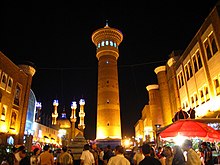
Written by Donovan May 6, 2015
Category: Asia, China
Tags: Beijing, forbidden city, national theatre, Qianmen, Tiananmen
Comments
On day two in Beijing, we romped the seemingly endless courtyards of the Forbidden City and stood in the centre of the Chinese universe Tiananmen square. I used to confuse those two because they are found in the same area. However, after reading the guide book for the explanation, I finally manged to differentiate the two. The Forbidden Palace was so named because it used to be off limits to everyone else except the royal dynasty who lived there during the Qing and Ming dynasties. Nowadays, the palace grounds are open to the public for viewing and you can gasp at the enormous scale of the palace which is like a well-contained city, reminiscent of the indulgences carried out by the royalty in the past. Just opposite the Forbidden city is the Tiananmen square which is a place filled with history and bloodshed that occurred during the 1989 uprising. where dissidents faced down tanks. Security checks were stringent as a form of precaution and I’m sure the government would not want a similar incident to occur again.

The National Arts Performing Centre is also situated nearby, it’s metallic dome structure casting a beautiful reflection in the pond outside under the afternoon sun. It could have been mistaken for an alien spaceship that has landed in Beijing for refuelling with its bulbous, shiny exterior. We escaped the crowds at the Forbidden city to find refuge in this tranquil place. There were tickets for sale by the English Ballet company who are performing Swan Lake and Copella at the theatre this week, but we found it to be out of our budget and decided to give it a miss.
In the late afternoon, we walked to Qianmen 前门 which literally means “front gate”. There was an ancient door called 朝阳门 which means it was facing the sun. It has a significant meaning as the sun played an important role to the Chinese since the olden days. I liked Qianmen district because it is a pedestrianised shopping area with many Western shops housed in a Chinese facade. One can see Starbucks and Swatch shops at Qianmen, housed in a temple-like structure with ornate carvings on the exterior.



Since Beijing hosted the summer Olympics in 2008, it has put China on the world map, showing its capability of organising such international events. We took the chance to visit the water cube (used for swimming events) and the bird nest (the stadium). The architecture was beautiful, but many complained that it has now become a white elephant after the event. However, on the day that we were there, many domestic tourists were there to visit the water cube and bird nest.


After Qianmen, we proceeded to Chaoyangmen 朝阳门 station as we wanted to buy bus tickets to Erenhot for Friday. However, we found out that it was the wrong place as the maps incorrectly brought us to there. Nevertheless we enjoyed walking around the area which is like Little Russia due to several Russian shops and businesses catering to Russians. The shop signs had both Chinese and Russian on them. We had dinner at a restaurant specialising in Western Chinese cuisine, meaning cuisine from Xinjiang area. It was interesting to see how people in headscarves prepared our food as they are the Muslim minority hailing from the western part of China. I could tell from their Chinese accent which was different from the standard one. Barbecued meats were on the menu as it is a staple for the people of that region and we had fried rice to go with it. I look forward to visiting Urumqi in a week’s time to understand more of the culture and traditions of that region.




